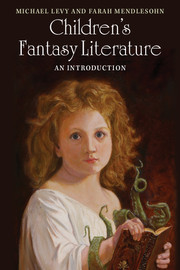Book contents
- Frontmatter
- Contents
- Acknowledgements
- Introduction
- 1 How fantasy became children's literature
- 2 Fairies, ghouls and goblins: the realms of Victorian and Edwardian fancy
- 3 The American search for an American childhood
- 4 British and Empire fantasy between the wars
- 5 The changing landscape of post-war fantasy
- 6 Folklore, fantasy and indigenous fantasy
- 7 Middle Earth, medievalism and mythopoeic fantasy
- 8 Harry Potter and children's fantasy since the 1990s
- 9 Romancing the teen
- Notes
- Further Reading
- Index
- References
1 - How fantasy became children's literature
Published online by Cambridge University Press: 05 April 2016
- Frontmatter
- Contents
- Acknowledgements
- Introduction
- 1 How fantasy became children's literature
- 2 Fairies, ghouls and goblins: the realms of Victorian and Edwardian fancy
- 3 The American search for an American childhood
- 4 British and Empire fantasy between the wars
- 5 The changing landscape of post-war fantasy
- 6 Folklore, fantasy and indigenous fantasy
- 7 Middle Earth, medievalism and mythopoeic fantasy
- 8 Harry Potter and children's fantasy since the 1990s
- 9 Romancing the teen
- Notes
- Further Reading
- Index
- References
Summary
Historians of children's literature begin their narratives in a variety of time periods, and with a specific range of texts, but these choices are not value neutral: each choice, for period or genre, tells the reader something about the historian's or critic's understanding of what childhood is, or what children's literature is. Children's fantasy has far stronger roots in tales of the fantastic than it does in tales for children: the history of children's fantasy is essentially one of appropriation, both children appropriating texts, and those who have written for children in the last three centuries appropriating and adapting their material for children. The close relationship between these processes may be one factor in the disproportionate representation of fantasy among those children's book titles which retain their popularity – beyond nostalgia – into the reading lives of adults.
Seth Lerer, in Children's Literature: A Reader's History, from Aesop to Harry Potter (2008), begins with the ancients and identifies children's literature less as a body of texts – which was generally shared with adults – than as a mode of delivery: the children of educated classical Greeks and Romans would have been introduced to the Iliad and the Aeneid, but would have been taught in excerpts, with an emphasis on memory, recitation and quotation, so that the well-rounded citizen could draw on a common culture of citizenry. This tradition lasted well into the twentieth century in the great British public schools and is well portrayed in that classic of children's literature, Tom Brown's Schooldays (1857) by Thomas Hughes. In this model of children's fiction, fiction is a thing for children, but not of them. It is a route out of childhood and into the adult world which does not treasure the child or childhood as something precious, and in which children's reading is contiguous with that of adults: it is primarily moralistic and therefore, as with Greek and Roman education, primarily civic.
This approach is valuable to the student of children's fantasy literature because much of what has become the matter (the themes or substance) of children's fantasy, particularly in the British tradition, is drawn from a core of texts never intended for children. One such text is the beast fable.
- Type
- Chapter
- Information
- Children's Fantasy LiteratureAn Introduction, pp. 11 - 26Publisher: Cambridge University PressPrint publication year: 2016

